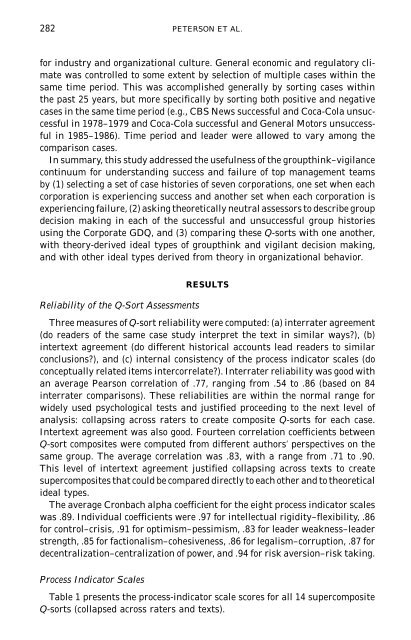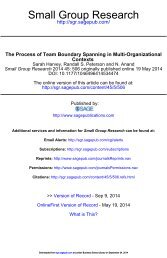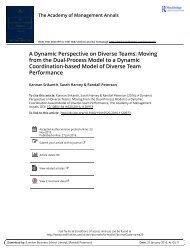Group Dynamics in Top Management Teams: Groupthink, Vigilance, and Alternative Models of Organizational Failure and Success
This study explored the heuristic value of Janis’ (1982) groupthink and vigilant decision making models as explanations of failure and success in top management team decision making using the Organizational Group Dynamics Q-sort (GDQ). Top management teams of seven Fortune 500 companies were examined at two historical junctures—one when the team was successful (defined as satisfying strategic constituencies) and one when the team was unsuccessful. Results strongly supported the notion that a group’s decision making process is systematically related to the outcomes experienced by the team. Ideal-type Q-sorts organized around Janis’ analysis of groupthink and vigilance were substantially correlated with Q-sorts of failing and successful groups, respectively. The fit was, however, far from perfect. Ideal type Q-sorts derived from other frameworks correlated better with the failure–success classification than did the Janis-derived ideal types. Successful groups showed some indicators of groupthink (e.g., risk-taking, cohesion, and strong, opinionated leaders), whereas unsuccessful groups showed signs of vigilance (e.g., internal debate to the point of factionalism). The results illustrate the usefulness of the GDQ for developing and empirically testing theory in organizational behavior from historical cases.
This study explored the heuristic value of Janis’ (1982) groupthink
and vigilant decision making models as explanations of
failure and success in top management team decision making
using the Organizational Group Dynamics Q-sort (GDQ). Top
management teams of seven Fortune 500 companies were examined
at two historical junctures—one when the team was successful
(defined as satisfying strategic constituencies) and one when the team was unsuccessful. Results strongly supported the notion
that a group’s decision making process is systematically related
to the outcomes experienced by the team. Ideal-type Q-sorts organized
around Janis’ analysis of groupthink and vigilance were
substantially correlated with Q-sorts of failing and successful
groups, respectively. The fit was, however, far from perfect. Ideal type
Q-sorts derived from other frameworks correlated better
with the failure–success classification than did the Janis-derived
ideal types. Successful groups showed some indicators of groupthink
(e.g., risk-taking, cohesion, and strong, opinionated leaders),
whereas unsuccessful groups showed signs of vigilance (e.g.,
internal debate to the point of factionalism). The results illustrate
the usefulness of the GDQ for developing and empirically testing
theory in organizational behavior from historical cases.
- No tags were found...
You also want an ePaper? Increase the reach of your titles
YUMPU automatically turns print PDFs into web optimized ePapers that Google loves.
282 PETERSON ET AL.<br />
for <strong>in</strong>dustry <strong>and</strong> organizational culture. General economic <strong>and</strong> regulatory climate<br />
was controlled to some extent by selection <strong>of</strong> multiple cases with<strong>in</strong> the<br />
same time period. This was accomplished generally by sort<strong>in</strong>g cases with<strong>in</strong><br />
the past 25 years, but more specifically by sort<strong>in</strong>g both positive <strong>and</strong> negative<br />
cases <strong>in</strong> the same time period (e.g., CBS News successful <strong>and</strong> Coca-Cola unsuccessful<br />
<strong>in</strong> 1978–1979 <strong>and</strong> Coca-Cola successful <strong>and</strong> General Motors unsuccessful<br />
<strong>in</strong> 1985–1986). Time period <strong>and</strong> leader were allowed to vary among the<br />
comparison cases.<br />
In summary, this study addressed the usefulness <strong>of</strong> the groupth<strong>in</strong>k–vigilance<br />
cont<strong>in</strong>uum for underst<strong>and</strong><strong>in</strong>g success <strong>and</strong> failure <strong>of</strong> top management teams<br />
by (1) select<strong>in</strong>g a set <strong>of</strong> case histories <strong>of</strong> seven corporations, one set when each<br />
corporation is experienc<strong>in</strong>g success <strong>and</strong> another set when each corporation is<br />
experienc<strong>in</strong>g failure, (2) ask<strong>in</strong>g theoretically neutral assessors to describe group<br />
decision mak<strong>in</strong>g <strong>in</strong> each <strong>of</strong> the successful <strong>and</strong> unsuccessful group histories<br />
us<strong>in</strong>g the Corporate GDQ, <strong>and</strong> (3) compar<strong>in</strong>g these Q-sorts with one another,<br />
with theory-derived ideal types <strong>of</strong> groupth<strong>in</strong>k <strong>and</strong> vigilant decision mak<strong>in</strong>g,<br />
<strong>and</strong> with other ideal types derived from theory <strong>in</strong> organizational behavior.<br />
Reliability <strong>of</strong> the Q-Sort Assessments<br />
RESULTS<br />
Three measures <strong>of</strong> Q-sort reliability were computed: (a) <strong>in</strong>terrater agreement<br />
(do readers <strong>of</strong> the same case study <strong>in</strong>terpret the text <strong>in</strong> similar ways?), (b)<br />
<strong>in</strong>tertext agreement (do different historical accounts lead readers to similar<br />
conclusions?), <strong>and</strong> (c) <strong>in</strong>ternal consistency <strong>of</strong> the process <strong>in</strong>dicator scales (do<br />
conceptually related items <strong>in</strong>tercorrelate?). Interrater reliability was good with<br />
an average Pearson correlation <strong>of</strong> .77, rang<strong>in</strong>g from .54 to .86 (based on 84<br />
<strong>in</strong>terrater comparisons). These reliabilities are with<strong>in</strong> the normal range for<br />
widely used psychological tests <strong>and</strong> justified proceed<strong>in</strong>g to the next level <strong>of</strong><br />
analysis: collaps<strong>in</strong>g across raters to create composite Q-sorts for each case.<br />
Intertext agreement was also good. Fourteen correlation coefficients between<br />
Q-sort composites were computed from different authors’ perspectives on the<br />
same group. The average correlation was .83, with a range from .71 to .90.<br />
This level <strong>of</strong> <strong>in</strong>tertext agreement justified collaps<strong>in</strong>g across texts to create<br />
supercomposites that could be compared directly to each other <strong>and</strong> to theoretical<br />
ideal types.<br />
The average Cronbach alpha coefficient for the eight process <strong>in</strong>dicator scales<br />
was .89. Individual coefficients were .97 for <strong>in</strong>tellectual rigidity–flexibility, .86<br />
for control–crisis, .91 for optimism–pessimism, .83 for leader weakness–leader<br />
strength, .85 for factionalism–cohesiveness, .86 for legalism–corruption, .87 for<br />
decentralization–centralization <strong>of</strong> power, <strong>and</strong> .94 for risk aversion–risk tak<strong>in</strong>g.<br />
Process Indicator Scales<br />
Table 1 presents the process-<strong>in</strong>dicator scale scores for all 14 supercomposite<br />
Q-sorts (collapsed across raters <strong>and</strong> texts).

















